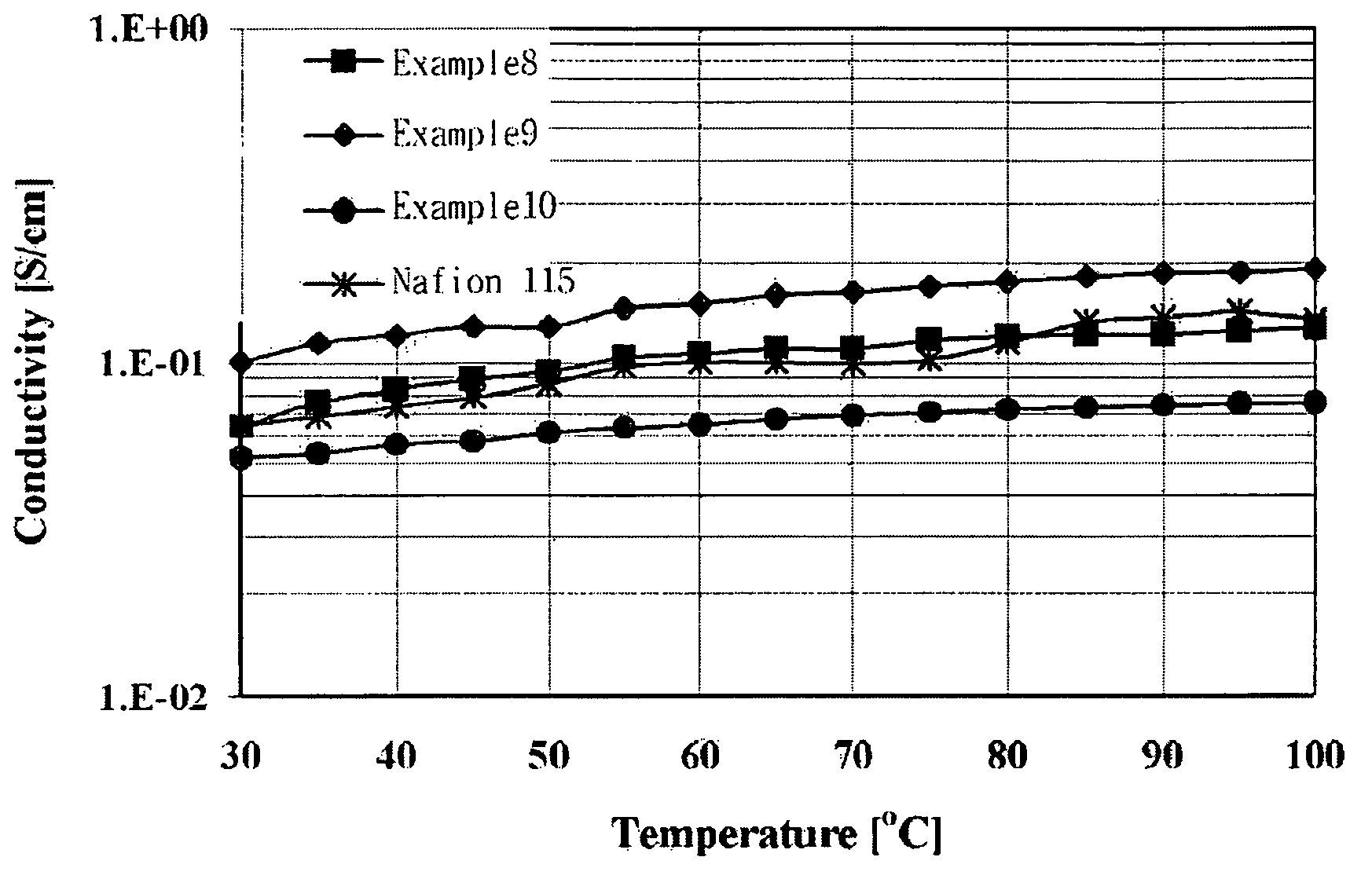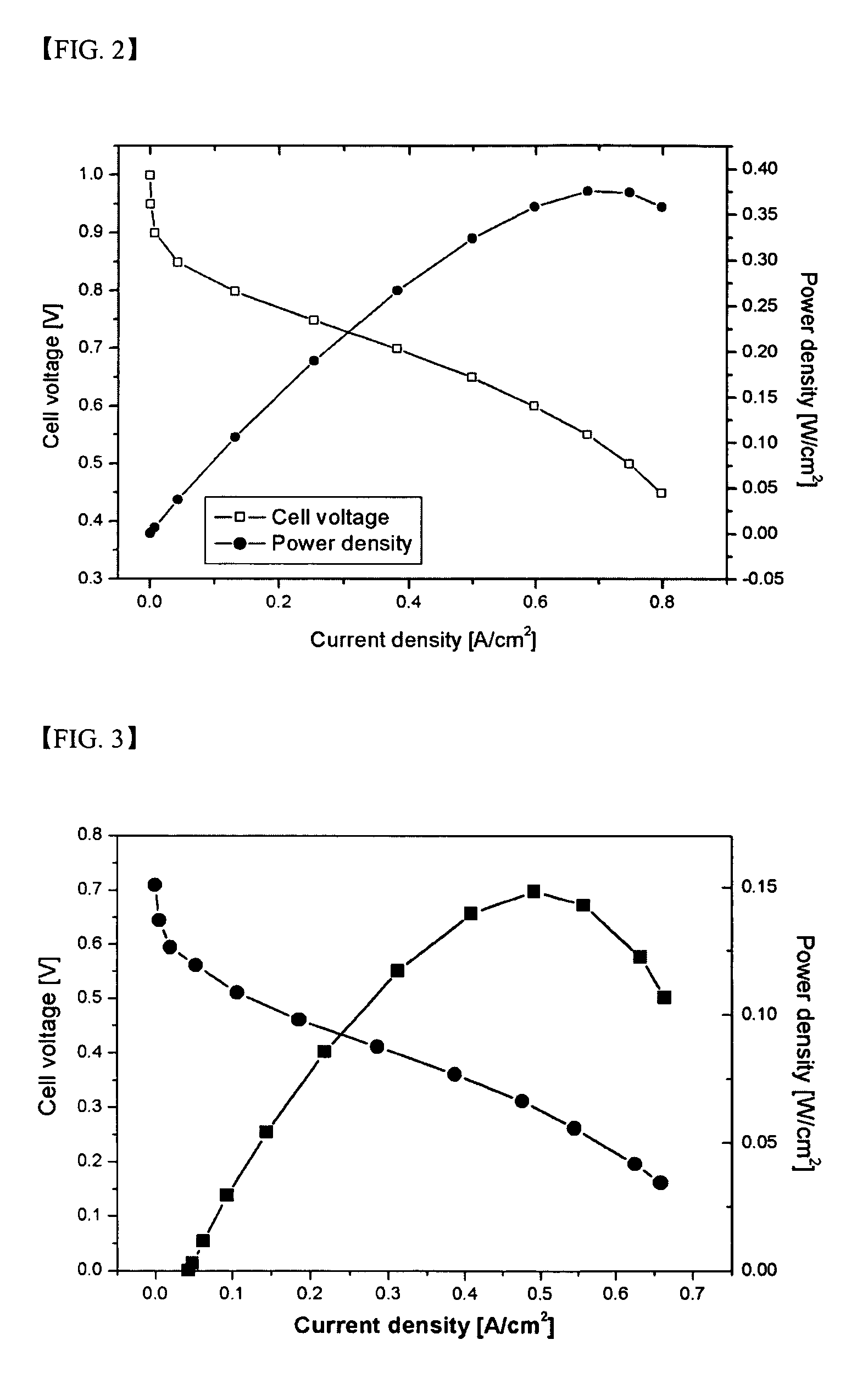Branched and sulphonated multi block copolymer and electrolyte membrane using the same
a multi-block copolymer and electrolyte technology, applied in the direction of sustainable manufacturing/processing, final product manufacturing, electrochemical generators, etc., can solve the problems of limited polymer availability, fuel cell capacity decrease, limitation in commercial use, etc., and achieve excellent mechanical properties and chemical stability, high proton conductivity
- Summary
- Abstract
- Description
- Claims
- Application Information
AI Technical Summary
Benefits of technology
Problems solved by technology
Method used
Image
Examples
example 1
Preparation of a Branched Hydrophobic Block Copolymer
[0084](Preparation of Brancher)
[0085]5 g of 1,3,5-benzenetricarbonyltrichloride (18.8 mol), 6.7 g of aluminum chloride (50.0 mmol) and 50 mL of distilled dichloromethane (DCM) were put in a 250 mL round flask, which was stirred for 30 minutes at 25° C. for reaction in the presence of nitrogen. 20 mL of dichloromethane and 4.5 g of fluorobenzene (48.8 mmol) were added in 100 mL of Dropping funnel, and the fluorobenzene solution was dropped in the round flask drop by drop. The reaction mixture was stirred for 4 hours in the presence of nitrogen, to which 20 mL of distilled water was added. The reaction mixture was stirred further for more than 12 hours. The organic layer of the reaction mixture was extracted by using dichloromethane, and the organic solvent was eliminated, resulting in a crude product. The crude product was re-crystallized using ethanol to give white brancher [3,5-bis(4-fluorobenzoyl)phenyl](4-fluorophenyl) methanon...
example 2
Preparation of a Branched and Sulphonated Multi Block Copolymer
[0092]13.082 g (2.616 mmol) of the branched hydrophobic block produced in the above Example 1 was mixed with 10.162 g (46.572 mmol) of 4,4′-difluorobenzophenone, 0.93 g (2.093 mmol) of [3,5-bis(4-fluorobenzoyl)phenyl](4-fluorophenyl)methanone, 11.945 g (52.328 mmol) of potassium hydroquinonesulfonate, 14.463 g (104.650 mmol) of potassium carbonate, 200 mL of dimethylsulfoxide and 120 mL of benzene.
[0093]The reaction mixture was stirred in an oil bath for 4 hours at 142° C. in the presence of nitrogen, during which benzene was flowing backward and azotrope attached on molecular sieves of Dean-stark apparatus was completely eliminated with pressurized nitrogen. Then, the reaction temperature was raised to 182° C. and 100 mL of dimethylsulfoxide was added, followed by polycondensation for 12 hours.
[0094]Upon completion of the reaction, 200 mL of dimethylsulfoxide was added to the reactant, which was then diluted. The dilute...
example 3
Preparation of a Branched and Sulphonated Multi Block Copolymer
[0095]Branched and sulphonated multi block copolymer-2 was prepared by the same manner as described in Example 2 except that 10.254 g (2.051 mmol) of the branched hydrophobic block prepared in Example 1, 12.231 g (56.055 mmol) of 4,4-difluorobenzophenone, 3.038 g (6.836 mmol) of [3,5-bis(4-fluorobenzoyl)phenyl](4-fluorophenyl)methanone, 11.945 g (52.328 mmol) of potassium hydroquinonesulfonate and 14.464 g (104.657 mmol) of potassium carbonate were used instead.
PUM
| Property | Measurement | Unit |
|---|---|---|
| temperature | aaaaa | aaaaa |
| temperature | aaaaa | aaaaa |
| temperature | aaaaa | aaaaa |
Abstract
Description
Claims
Application Information
 Login to View More
Login to View More - R&D
- Intellectual Property
- Life Sciences
- Materials
- Tech Scout
- Unparalleled Data Quality
- Higher Quality Content
- 60% Fewer Hallucinations
Browse by: Latest US Patents, China's latest patents, Technical Efficacy Thesaurus, Application Domain, Technology Topic, Popular Technical Reports.
© 2025 PatSnap. All rights reserved.Legal|Privacy policy|Modern Slavery Act Transparency Statement|Sitemap|About US| Contact US: help@patsnap.com



